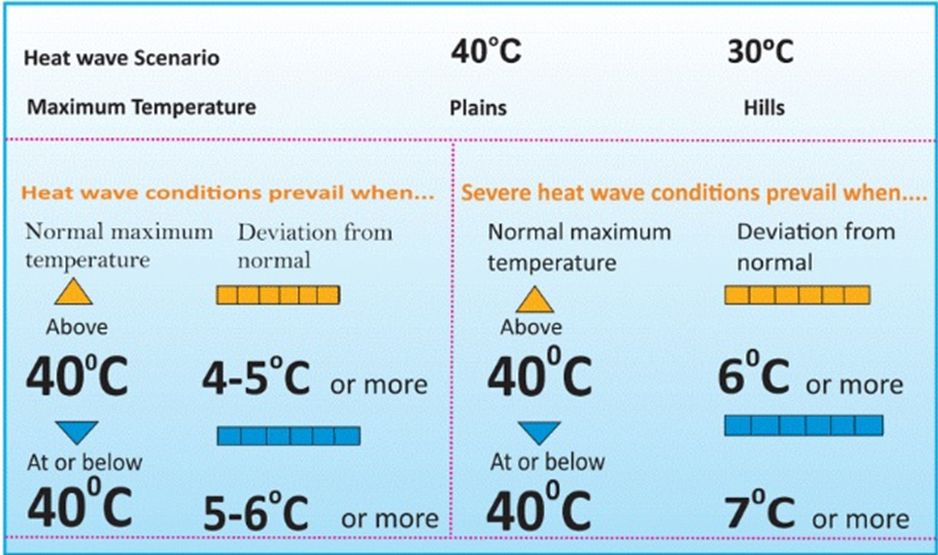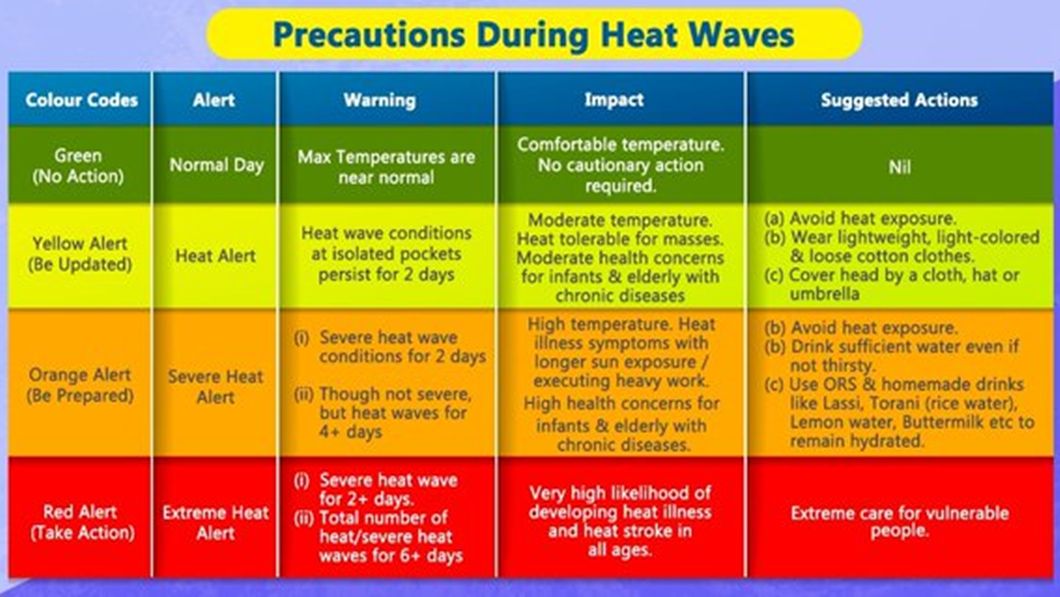ON INDIA’S ‘HEAT ACTION PLANS’
Relevance: GS 3 – Disaster and disaster management.
Why in the News?
- The India Meteorological Department (IMD) typically issues heat alerts during the summer months, but this year alerts began in February.
- Parts of northeast and western India have already experienced significantly warmer temperatures, 1-5 degrees Celsius above normal.
- The IMD predicts an increase in maximum temperatures and more frequent heatwave conditions in the coming days, especially over eastern and southern India.
Questions on India’s Preparedness
Questions arise about India’s preparedness to face this increasing hazard.
- How does the IMD define heatwaves?
- Are special interventions required for vulnerable communities during a heatwave?
- What are the regional variations and socio-economic differences in facing heatwave conditions?
What is a heatwave?
- The definition of a heatwave by the IMD varies based on the physiography of regions.
- The IMD declares a heatwave if:
- Maximum temperature recorded is 40°C or more in the plains.
- 37°C or more in the coast.
- 30°C or more in the hills.
- Severity of a heatwave is determined by temperature departure from normal:
- ‘Normal heatwave’: 4.5-6.4°C departure.
- ‘Severe heatwave’: Departure greater than ‘normal heatwave’.
- Heatwave can also be declared based on actual maximum temperature:
- ‘Heatwave’: >45°C.
- ‘Severe heatwave’: >47°C.
- IMD uses the latter two criteria when:
- At least two stations in a subdivision report high maximum temperatures.
- At least one station records a departure from normal for two consecutive days.
How is India tackling heatwaves?
- Governments at various levels (State, district, city) have prepared Heat Action Plans (HAPs) due to increasing heatwave severity and frequency.
- HAPs aim to:
- Increase preparedness.
- Lower adverse impacts of extreme heat.
- National Disaster Management Authority and IMD are working with 23 States to develop HAPs.
- Centralized data on HAPs is unavailable, but:
- At least 23 HAPs exist at the State and city level.
- States like Odisha and Maharashtra have district-level HAPs.
- General pattern of HAPs:
- Provide a region’s heat profile.
- Number of past heatwave events.
- Yearly trends in summer maximum temperature.
- Land surface temperature, etc.
- Conduct a vulnerability assessment to identify regions needing immediate attention.
- Outline a response plan recommending:
- Mitigation strategies.
- Measures for before, during, and after a heatwave.
- Define roles and responsibilities of various line departments:
- Disaster management authority.
- Labour department.
- Police, etc.
- Provide a region’s heat profile.
HAP Recommendations for Public Awareness and Early Warning:
- Use forecasts and early warning systems to alert the public and relevant authorities about impending heatwaves.
- Educate the public through campaigns: Provide information on risks associated with heatwaves.
- Infrastructure and Resource Provision:
- Build heat shelters and cooling centres to provide relief during heatwaves.
- Provide clean drinking water to prevent dehydration during extreme heat events.
- Healthcare Preparedness: Direct hospitals to:
- Be well-equipped with necessary supplies.
- Have an adequate number of trained healthcare workers to recognize and treat heat-related illnesses.
- Long-term Mitigation Strategies: Adopt urban planning strategies that promote:
- Tree planting to increase green cover and natural shade.
- Use of heat-resistant building materials to reduce the urban heat island effect.
- Implement cool roofing technologies to reduce solar absorption and decrease indoor temperatures.
- Stakeholder Coordination: Advocate for effective coordination among
- Government agencies.
- Healthcare providers.
- Community organizations.
- Emergency services to ensure a cohesive response to heatwave events.
Challenges in Effective Implementation of HAPs:
- Local Context and Definition: Current national threshold for a heatwave may not accurately reflect local conditions. Heatwaves need to be determined at disaggregated scales: States, districts, and cities.
- Factors affecting local temperature: Urban heat island effect, Type of roofing, Proximity to water or green bodies, Humidity and warmer nights.
- Need to expand scope to include: Humid heat and warmer nights,
- Development of a comprehensive heat index accounting for multiple factors beyond just temperature.
- Regional variations: HAPs should be tailored to specific Climatic conditions, Demography, Infrastructure.
- Resource Allocation: Implementation varies based on Priorities of local governments, Available capacities.
- Need of dialogue between State, Civil society organizations, Worker unions to co-plan financial mechanisms.
- Ensure informal workers can be indoors during a heatwave without losing income.
- Inconsistent Methods: Variability in vulnerability assessments across HAPs. Transition to a robust climate risk assessment needed to:
- Identify likelihood of heatwaves in different areas.
- Estimate exposure of people and assets to heatwaves.
- Factor in inherent vulnerabilities.
- Hotspot mapping required for:
- Prioritizing and formulating targeted interventions.
- Utilizing readily available geospatial data.
- Vulnerable Populations: All HAPs prioritize protection of vulnerable groups like Low-income communities, Children, Elderly.
- Missing targeted interventions: Accounting for local social and demographic factors.
- Infrastructure that could exacerbate heat. Over 90% of India’s economy is informal. Strategies must consider various socio-economic differences.
- Need for dedicated budgets for HAPs.
- Breaking Down Silos: HAPs are currently stand-alone plans with limited finance. Integration with broader action plans promoting:
- Urban resilience.
- Climate adaptation is crucial.
- Integration likely to improve Effectiveness of HAPs, Implementation, Data collection and monitoring systems.
- Long-Term Measures and Infrastructure:
- HAPs mainly focus on Building infrastructure, especially cool roofs.
- Need for focused planning on Nature-based solutions to address extreme heat in hotspots.
Mains question
Discuss the efficacy and challenges of Heat Action Plans (HAPs) in India. Examine the need for localized approaches and resource allocation to effectively address the increasing frequency and severity of heatwaves. (250 words)





